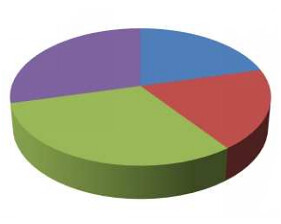Structural engineers can make a significant contribution to the sustainability of the built environment by considering disaster resilience in their designs. Download the SEI Sustainability Committee Disaster Resilience Working Group's definitive guide and learn how to design more resilient structures. Click here and look for the link to download at the bottom of the page.
Sustainability encompasses three spheres: economic, environmental, and social. Within each of these spheres, sustainability requires providing for the needs of the present while allowing future generations to meet their own needs. Disaster resilience pertains to the ability to suffer less damage and recover more quickly from adverse events such as hurricanes and earthquakes. A resilient structure provides socially valuable services such as shelter and safety, even in the face of disaster, and it should do so while minimizing economic and environmental costs. Ignoring resilience during design can lead to structures that may seem green but that cannot reliably provide the services that we expect from them. Sustainability and disaster resilience are related in complex ways. Often times striving for one will help achieve the other as when a more robust structure reduces the environmental and economic cost of repairing extensive damage. Sometimes the two are at cross-purposes. For example, striving for material efficiency may render a structure less redundant, and hence less safe in a disaster.
The main section of this report discusses a variety of efforts to promote resilience and resources for resilient design. Some of these are prescriptive, offering a set of design rules more stringent than existing building codes. Others are performance-based, offering performance criteria and methods for predicting the performance. Prescriptive criteria are simpler, but do not explicitly assure better performance. Performance-based approaches allow the designer to provide specified improvements in performance, but this requires much more effort to achieve. Some of the efforts are voluntary and others are intended to become model codes. Voluntary efforts depend on the desire of the owner or developer to enforce the guidelines. Model codes aim to become law that all designers and builders must follow. Voluntary initiatives may become accepted more quickly and be more adaptable to changing times, but efforts to change model codes have the potential to effect change more broadly.
The report also discusses current efforts to quantify the connection between disaster resilience and sustainability through life cycle methods. There is no current agreement as to the best way of achieving this, nor are there standard tools for the structural engineer to use in everyday practice. However, it is important to remain aware of developments in this area, as it will likely become a common consideration in structural design. The structural engineer who stays abreast of developments, and even better, who contributes to them ñ will be at an advantage when these methods mature.
In the interest of encouraging positive and meaningful action, the report provides the following suggestions for structural engineers who are interested in supporting disaster resilience and sustainability:
Concluding the report is a thoughtful afterword on resilience and sustainability in developing countries. The afterword suggests considerations for those interested in projects in these countries and provides potential solutions to common challenges, some of which can inform design practices in developed countries such as the United States.
Read more...
Executive Summary
The importance of sustainability within structural engineering has become more widely accepted in recent decades. When structural engineers think of sustainability, they often limit their scope to material selection and recycling. Few structural engineers recognize the relationship between sustainability and disaster resilience, an area in which they can make significant contributions. Consequently, the aims of this report are to- Raise awareness of the relationship between disaster resilience and sustainability by discussing how a holistic view of sustainability must recognize the need for disaster resilience, and to
- Provide a critical review of resilience-related efforts and resources available to practicing structural engineers and related professionals.
Sustainability encompasses three spheres: economic, environmental, and social. Within each of these spheres, sustainability requires providing for the needs of the present while allowing future generations to meet their own needs. Disaster resilience pertains to the ability to suffer less damage and recover more quickly from adverse events such as hurricanes and earthquakes. A resilient structure provides socially valuable services such as shelter and safety, even in the face of disaster, and it should do so while minimizing economic and environmental costs. Ignoring resilience during design can lead to structures that may seem green but that cannot reliably provide the services that we expect from them. Sustainability and disaster resilience are related in complex ways. Often times striving for one will help achieve the other as when a more robust structure reduces the environmental and economic cost of repairing extensive damage. Sometimes the two are at cross-purposes. For example, striving for material efficiency may render a structure less redundant, and hence less safe in a disaster.
The main section of this report discusses a variety of efforts to promote resilience and resources for resilient design. Some of these are prescriptive, offering a set of design rules more stringent than existing building codes. Others are performance-based, offering performance criteria and methods for predicting the performance. Prescriptive criteria are simpler, but do not explicitly assure better performance. Performance-based approaches allow the designer to provide specified improvements in performance, but this requires much more effort to achieve. Some of the efforts are voluntary and others are intended to become model codes. Voluntary efforts depend on the desire of the owner or developer to enforce the guidelines. Model codes aim to become law that all designers and builders must follow. Voluntary initiatives may become accepted more quickly and be more adaptable to changing times, but efforts to change model codes have the potential to effect change more broadly.
The report also discusses current efforts to quantify the connection between disaster resilience and sustainability through life cycle methods. There is no current agreement as to the best way of achieving this, nor are there standard tools for the structural engineer to use in everyday practice. However, it is important to remain aware of developments in this area, as it will likely become a common consideration in structural design. The structural engineer who stays abreast of developments, and even better, who contributes to them ñ will be at an advantage when these methods mature.
In the interest of encouraging positive and meaningful action, the report provides the following suggestions for structural engineers who are interested in supporting disaster resilience and sustainability:
- Becoming better informed by using the references and links in this document.
- Participating in the code adoption process to encourage resilient design standards.
- Supporting legislation that requires or provides incentives for resilient construction.
- Educating owners regarding the importance and value of resilient construction.
- advocating with insurance companies and portfolio managers to offer decreased costs for better performing facilities.
- Advocate with ASCE, SEI and other professional organizations to raise the profile of structural engineers.
Concluding the report is a thoughtful afterword on resilience and sustainability in developing countries. The afterword suggests considerations for those interested in projects in these countries and provides potential solutions to common challenges, some of which can inform design practices in developed countries such as the United States.














